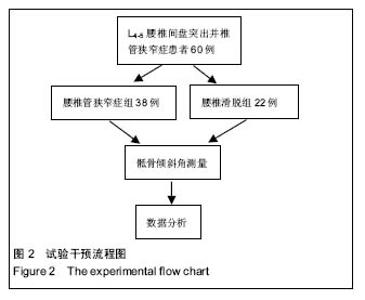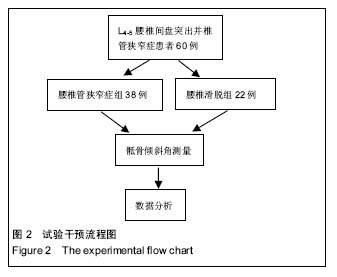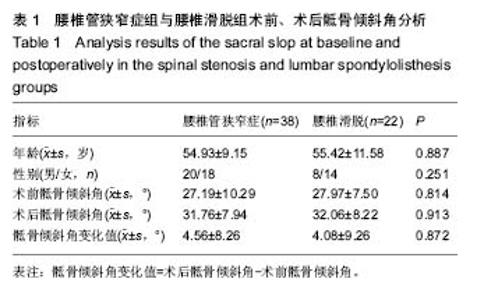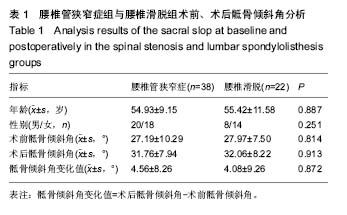| [1] 贾俊峰,赵杰,陈志明,等.腰椎峡部裂型滑脱症矢状位参数分析[J].中国矫形外科杂志,2007,15(11):850-852.[2] 郭金明,阿里木江.成年人下腰痛与腰椎前凸和骶骨倾斜角的关系[J].实用骨科杂志2007,13(10):577-579.[3] Lazennec JY, Ramare S, Arafati N, et al. Sagittal alignment in lumbosacral fusion: relations between radiological parameters and pain. Eur Spine J. 2000;9(1):47-55.[4] 任杭岭,耿伟,马金柱,等.腰椎滑脱症患者手术前后脊柱-骨盆矢状位参数变化与临床疗效的相关性分析[J].中国修复重建外科杂志,2015,29(10):1269-1274.[5] Feng Y, Chen L, Gu Y, et al. Influence of the posterior lumbar interbody fusion on the sagittal spino-pelvic parameters in isthmic L5-S1 spondylolisthesis. J Spinal Disord Tech. 2014; 27(1):E20-E25. [6] Adogwa O, Parker SL, Bydon A, et al. Comparative of ectiveness of minimally invasive versus open transforaminal lumbar interbody fusion: 2-year assessment of narcotic use, return to work, disability, and quality of life. J Spinal Disord Tech.2011;24(8):479-484.[7] Macnab I. Negative disc exploration: an analysis of nerve root involvement in sixty eight patients. J Bone Joint Surg (Am).1971;53(5):891-903.[8] Philippot R, Wegrzyn J, Farizon F, et al. Pelvic balance in sagittal and Lewinnek reference planes in the standing, supine and sitting positions. Orthop Traumatol Surg Res. 2009;95(1):70-76.[9] Jackson RP, McManus AC. Radiographic analysis of sagittal plane alignment and balance in standing volunteers and patients with low back pain matched for age, sex, and size. A prospective controlled clinical study. Spine (Phila Pa 1976). 1994;19(14):1611-1618.[10] Winterstein JF. Measuring the sacral inclination angle in clinical practice: is there an alternative to radiographs? J Manipulative Physiol Ther. 2002;25(2):139-140.[11] 郑丰裕.慢性下腰痛患者立位X射线侧位片测量及其相关分析[J].中华骨科杂志,1996,16(7):27-30.[12] Barrey C, Jund J, Noseda O, et al. Sagittal balance of the pelvis-spine complex and lumbar degenerative diseases. A comparative study about 85 cases. Eur Spine J. 2007;16(9): 1459-1467.[13] Adams MA, Hutton WC. The effect of posture on the role of the apophysial joints in resisting intervertebral compressive forces. J Bone Joint Surg Br.1980;62(3):358-362.[14] Rajnics P, Templier A, Skalli W, et al. The association of sagittal spinal and pelvic parameters in asymptomatic persons and patients with isthmic spondylolisthesis. J Spinal Disord. 2012;15(1):24-30.[15] Satomi K, Hirabayashi K, Toyama Y, et al. A clinical study of degenerative spondylolisthesis: radiographic analysis and choice of treatment. Spine (Phila Pa 1976). 2013;17(21): 1329-1336. [16] 刘勇,刘臻,朱锋,等.成人腰椎峡部裂性滑脱症与退变性滑脱症患者脊柱骨盆矢状面形态学研究[J].中国脊柱脊髓杂志, 2013, 23(4):307-311.[17] Park SJ, Lee CS, Chung SS, et al. Postoperative changes in pelvic parameters and sagittal balance in adult isthmic spondylolisthesis. Neurosurgery. 2011;68(2 Suppl Operative): 355-363.[18] 万仲贤,陈泽,李强.PLIF手术对退变性腰椎滑脱症脊柱骨盆参数影响及疗效分析[J].颈腰痛杂志,2016,37(5):416-420.[19] 何克云,李志忠,李宁宁,等.L(4-5)后路椎体间融合治疗后早期腰椎前凸角度的变化[J].中国组织工程研究, 2012,16(17): 3087-3090.[20] 黎裕明,黄宗贵,戴海,等.扩大半椎板切除+对侧潜行减压椎间融合术治疗腰椎管狭窄疗效分析[J].中华临床医师杂志:电子版, 2015,9(12):2410-2413.[21] 李建江,楚戈,杨涛,等.经皮椎间孔镜下TESSYS技术修复腰椎固定融合后邻近节段退行性变[J].中国组织工程研究,2015,19(26): 4186-4190.[22] 陈肇辉,付强,王聪,等.腰椎后路单节段融合与非融合固定的对比分析[J].中国矫形外科杂志,2010,18(8):629-632.[23] Min K, Liebscher T, Rothenfluh D. Sacral dome resection and single-stage posterior reduction in the treatment of high-grade high dysplastic spondylolisthesis in adolescents and young adults. Eur Spine J. 2012;21 Suppl 6:S785-S791.[24] de Medeiros RC, Jaccard AP, Cliquet A Jr. Sagittal spinal alignment in paraplegics: a new paradigm for the rehabilitation under neuromuscular electrical stimulation. Spinal Cord, 2010;48(3):251-256.[25] Lee SH, Lee JH, Hong SW, et al. Spinopelvic alignment after interspinous soft stabilization with a tension band system in grade 1 degenerative lumbar spondylolisthesis. Spine (Phila Pa 1976). 2010;35(15):E691-E701.[26] Kim JS, Lee KY, Lee SH, et al. Which lumbar interbody fusion technique is better in terms of level for the treatment of unstable isthmic spondylolisthesis? J Neurosurg Spine. 2010; 12(2):171-177.[27] 胡建伟,尹承慧,张帅.腰椎后路融合术后邻近节段退变疾病再手术的危险因素分析[J].中国骨与关节损伤杂志, 2016,31(7): 712-714.[28] 向俊宜,孟庆奇,赵文韬,等.后路椎弓根钉内固定结合单纯椎间植骨融合与椎间融合器治疗腰椎不稳的疗效比较[J].广东医学, 2012, 33(22):3423-3425.[29] Bjarnason JA, Reikeras O. Changes of center of rotation and femoral offset in total hip arthroplasty. Ann Transl Med. 2015; 22(3):355. [30] 王少飞,晁建虎,杨永辉,等.保留后方韧带复合体椎间融合术与PLIF技术治疗腰椎间盘突出症的比较分析[J].中国骨与关节损伤杂志,2014,29(5):476-477.[31] Satomi K, Hirabayashi K, Toyama Y, et al. A clinical study of degenerative spondylolisthesis. Radiographic analysis and choice of treatment. Spine (Phila Pa 1976). 1992;17(11): 1329-1336. |



